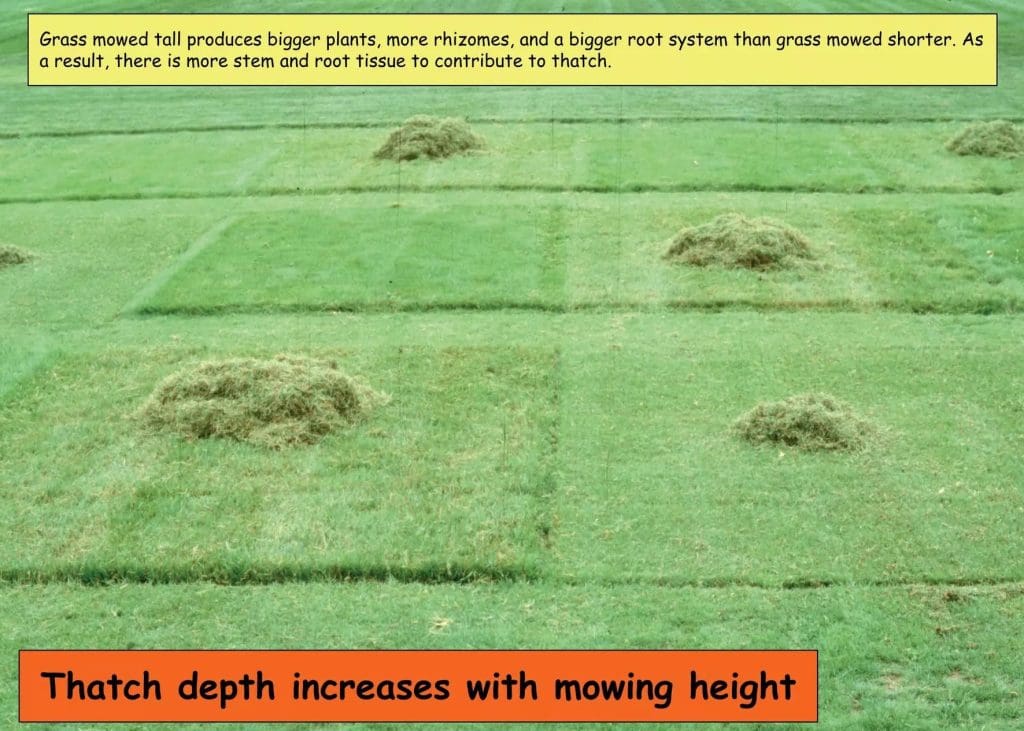Thatch is a layer of organic material that forms between soil and grass, consisting of dead and living grass stems, roots, and shoots.
It develops when organic matter breaks down more slowly than it’s produced, often due to factors like grass species, soil microbial activity, and lawn care practices.
While a thin layer of thatch (less than 12 to 13mm) can be beneficial by providing root insulation and moisture retention, excessive thatch can create significant problems for lawn health. Thick thatch prevents water and air penetration, harbours diseases and pests, and impedes nutrient absorption. Managing thatch requires balanced lawn maintenance, including core aeration, proper mowing, careful fertilisation, and occasional dethatching to ensure a healthy lawn.
Cutting height
Cutting turf at a higher height can contribute to an increased buildup of thatch over time. When grass is left longer, it produces more top growth, leading to a greater amount of organic material being deposited on the soil surface. While this may seem beneficial for protecting the soil, the increased leaf material that is not broken down as quickly can contribute to a thicker thatch layer.

Avoid fast-release fertilsers
At NZLA we don’t sell fast-release fertilsers for several reasons that we could write an article on its own about!
Fast-release fertilisers can significantly contribute to lawn thatch buildup by causing rapid, uneven grass growth that leads to excessive organic matter accumulation. These quick-acting fertilisers stimulate intense grass blade growth while often neglecting root development, resulting in weak root systems and increased dead grass tissue. The surge of nutrients causes grass to grow faster than it can naturally decompose, creating a dense layer of partially decomposed organic material between the soil surface and the green grass blades.
In contrast, slow-release fertilisers like All Seasons and All Seaons N+ provide a more gradual and consistent nutrient supply, promoting balanced root and blade growth, improving soil health, and reducing thatch accumulation. Slow-release options encourage more even grass development, support beneficial soil microorganisms that help break down organic matter, and ultimately result in a healthier, more resilient lawn with less thatch buildup.
By following the NZLA Application Guide you can ensure you’re not exceeding or getting anywhere near the level of nitrogen that causes excessive thatch buildup.
Grass species
Some turfgrass species produce large amounts of stem tissue as rhizomes or stolons. Consequently, these species form more thatch than others. The thatch forming cool season grasses are Kentucky bluegrass, creeping red fescue, and creeping bentgrass. Perennial ryegrass and tall fescue are primarily bunch-type grasses and do not produce significant thatch build up.
Grass clippings
A common belief used to be that leaving grass clippings on the lawn would cause excess thatch buildup. However, research has shown that with proper lawn maintenance strategies, grass clippings do not cause a significant increase in thatch buildup. That’s because thatch is made up of those parts of the plants that don’t decay as easily. Grass blades usually do break down easily.
Acid soils and reduced microbe activity.
Thatch accumulation can occur when soil conditions do not support the high populations of microorganisms needed for its decomposition. Soils with a low pH (5.5 or below) tend to hinder the growth of these decomposing organisms, which leads to a quicker build-up of thatch.
Additionally, soils rich in clay or sand may have fewer microorganisms capable of breaking down organic matter, making thatch accumulation more likely. Compacted or poorly structured soils also create unfavourable conditions for microbial activity, contributing to the persistence of thatch. When soil has poor structure or becomes compacted, it limits the movement of air and water, which further inhibits microbial life and allows thatch to build-up.
Maintaining a healthy soil structure, with a balanced pH and good texture, is essential to prevent excessive thatch formation and promote the breakdown of organic material.
At NZLA we sell a few products to promote microbial activity, two of the top selling products being Nurture and Restore. The shelf life of these products is only 12 months due to the products containing live microbes, so only get enough for the coming season.
Removing thatch
A good thatch management programme requires preventing thatch buildup as well as physical removal.
A preventative programme centres on appropriate species and cultivar selection, liming, core aeration, and proper pesticide and fertiliser use. Physical removal can be accomplished with vertical mowers or other thatch removal equipment.
Typically, when thatch layers reach 25mm or more, preventative practices won’t provide adequate control. In such cases, thatch must be physically removed. As the unit moves over the turf, the rotating blades slice into the thatch, bringing up organic debris. You can adjust the blades on vertical mowers to different depths, allowing you to regulate how much thatch you remove.
Lawn coring
By breaking up compacted soil, coring enhances microbial activity, which is crucial for the decomposition of thatch. The improved soil structure also provides a better environment for microorganisms that break down organic matter, helping to reduce the build-up of thatch over time. Regular coring can significantly improve the overall health of the turf and prevent the excessive accumulation of thatch.
See our guide on coring you lawn.
Comments
0